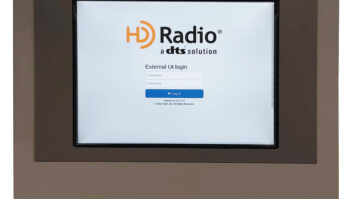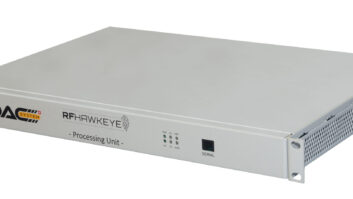Some 30 years ago, my complement of RF test equipment consisted of a General Radio 1606B impedance bridge (GR bridge), a Potomac SD31 synthesizer-detector and a Delta OIB-1 operating impedance bridge. That was quite a load to haul around, as you can see the large GR bridge in Fig. 1, but it all did what I needed it to. I was able to resonate transmission lines, set up networks, measure driving point impedances and match lines to loads.

A few years later, I got a Hewlett-Packard 4815A vector impedance meter and couldn’t imagine how I had lived without it. Instead of going through all the steps of setting the initial balance on the GR bridge, compensating for lead length and balancing the bridge with the resistance and reactance dials, the vector impedance meter worked like an ohmmeter — just put the probe across the component or leg and directly read the impedance in polar format.
For pure reactance, as you would find in a network leg, the phase would be + or –90, and the magnitude would directly indicate the reactance. That piece of equipment sure sped up the process of tuning up antennas, networks, combiners and low-pass filters.
Resonating sample and transmission lines with the GR bridge was a painstaking process because it required a new initial balance after every frequency change, and those controls were touchy!
With the vector impedance meter, it was a simple matter of cranking the frequency dial and watching for the phase to swing through zero with a low magnitude (with the far end of the line open). I would connect a frequency counter to the oscillator output of the vector impedance meter so I could get better resolution on frequency than I could read off the analog dial. The point is, I could resonate every transmission and sample line in a system and have the exact electrical length in a matter of minutes instead of hours.
NEW DEVICE, NEW CAPABILITIES
Ten years later, I made another RF test equipment move, this time to a vector network analyzer (VNA). I got a Hewlett-Packard 4195A four-port analyzer. In some ways, this was a giant step backward because the thing weighed as much as the whole pile of predecessor test equipment. In the shipping case, the thing was the size of a small refrigerator!
Still, that VNA opened up a whole new world for me, allowing me to make different kinds of measurements than I could with bridges and vector meters. Among other things, that analyzer allowed me to optimize loads to the driving power amplifiers.
Sure, I could have done that with the bridge, but I would have had to make seven or more separate measurements, each on a different frequency within the passband, resetting the initial balance on each new frequency before making each measurement. Then I would have to plot each measurement on a Smith chart and connect the dots to see what the impedance plot looked like.
One thing I learned was how easy it was to miss a “knot” in the impedance sweep that might occur between 5 kHz measurement points made with a bridge. Such knots were not uncommon when using a broadbanding network in a system, and they could in some cases drive a power amplifier crazy. The VNA, making measurements every few hundred Hertz, would not miss a knot and the impedance plot would be conveniently displayed on the screen.
I also learned that the VNA could be used with a linear power amplifier, attenuators and directional couplers to improve the signal-to-noise ratio of the measurement. With such an arrangement, the VNA could directly measure the impedance plot of a tower, antenna or array. Of course, the amplifier and case full of attenuators, couplers and cables made the haul-around pile even bigger and heavier!
What about adjusting network legs, particularly those at a tower base? It would hardly be easy to lug that hundred-pound beast out to a tuning house or antenna tuning unit cabinet, set it up and use it to adjust a network. The great news is that I found I didn’t have to haul anything to a tower base except a piece of RG-58 with N-connectors on both ends and a short pigtail with an N-connector on one end and a pair of alligator clips on the other.
You see, the VNA could be calibrated at the end of a transmission line of any length. It was a simple matter to run through the calibration procedure with the open, short and 50-ohm load on the end of the RG-58 jumper connected to the sample line to a tower. With that done, the pigtail with its alligator clips would be connected to the end of the RG-58 and then clipped across coils or network legs. A helper would do that in the ATU cabinet or tuning house while I ran the VNA from the air-conditioned (or heated) comfort of the transmitter building. What could be better?

Transmission lines were also a piece of cake to both resonate and measure the characteristic impedance with the VNA. Using the known (or assumed) physical length of a line as a guideline, set the start and stop frequencies of the sweep and observe the spiral of the open-circuited line on the Smith chart display, as seen in Fig. 2. Every crossing of the zero reactance axis on the left side of the display represented the frequency of an odd multiple of quarter wavelengths. The relationships between the crossing frequencies made it easy to determine what multiple was which.
Once the exact frequency of the desired multiple closest to the carrier frequency was determined, it was an easy matter of checking the open-circuit impedance 45 degrees on either side of that and taking the geometric mean to determine the characteristic impedance of the line.
Still, shipping that big old beast around was expensive, a real pain, and it was hard on the unit itself. After a few years, I bought an Agilent E8061A two-port analyzer. It weighed less than 30 pounds, a big improvement over the 4195A. Its shipping case was a Pelican roll-on, making it fairly easy and convenient to haul it around or ship it as necessary. It would do most of what the “big boy” would do, and it had other capabilities as well. I still use the E8061A on a regular basis.
SMALL PACKAGE, BIG PERFORMANCE
It was in 2014, however, that I made my latest acquisition, an Array Solutions PowerAIM-120 vector network analyzer. Instead of 30 pounds, it weighs about one pound. In its carrying case with power supply, battery, cables and calibration loads, it weighs less than 10 pounds and I can carry it aboard an airplane or even put it inside a checked bag. Fig. 3 shows how compact the analyzer is.

This little wonder works sort of like a software-defined radio in that you connect it to a PC, usually a notebook, and the PC does all the heavy lifting. The PowerAIM merely provides the interface to the outside world.
Because it is a single-port analyzer, you’re limited to S11-type measurements (that is, measuring the power reflected from the antenna or load). You can’t use it with the power amplifier, attenuators and directional coupler, but it does have enough juice to get over most of the interference that you would typically see coming in on an antenna. It’s probably not going to blast past a 50 kW third-adjacent across town, but it’s hard to imagine why someone would be looking that far out in the first place. I regularly use it to resonate sample lines at sites with the transmitter on the air at full power.
You can’t beat the PowerAIM for setting up a network. It’s easy enough to haul a notebook PC and PowerAIM out to an ATU, or you can calibrate at the end of a sample line and have a helper do all the work outside while you operate the PC and PowerAIM from inside the transmitter building.

It also has band scan, stub tuning, Q measurement, VSWR bandwidth and time domain reflectometer (TDR) functions, making it a truly powerful little device (although again, the secret is that the power is in the PowerAIM software running on the PC). Fig. 4 shows a screen shot of a sweep of a sample line, and Fig. 5 shows the same measurement in a Smith chart.

As small as the PowerAIM is, there are even smaller, lighter devices now on the market. Array Solutions has a much less expensive, lower-power VNA very much like the PowerAIM available, and we have one of these devices in my company. We don’t connect it to an antenna or array because it doesn’t have the juice to get over the junk coming in, but it works great for resonating and measuring transmission lines and setting up network legs, even tuning diplex filters.

One of our engineers recently purchased a SARK-110 Vector Impedance Analyzer. That little device operates from 110 kHz to 230 MHz, has a touch-screen (requires no external PC) and as you can see in Fig. 6, it’s about the size of a smartphone. It’s understandably short on output power (–10 dBm max), but it should work fine for resonating lines and setting up network legs.
If you had told me 30 years ago that someday engineers would be able to carry the equivalent of that big old pile of test equipment in their shirt pockets, I would have thought you were nuts! And yet here we are. It’s fun to remember the days of bridges, oscillators and detectors, but given the chance, I wouldn’t want to go back.
W.C. “Cris” Alexander is director of engineering at Crawford Broadcasting Co. and a longtime Radio World contributor. He is an SBE Fellow and past recipient of the Robert W. Flanders SBE Engineer of the Year award.
Comment on this or any story. Email [email protected].












